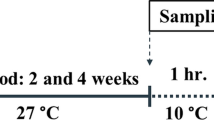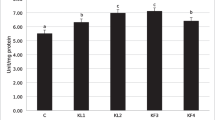Abstract
The objective of this study was to investigate whether zinc (Zn) along with magnesium (Mg) is effective in alleviating the negative effects of heat stress in Japanese quails. One hundred and twenty 10-day-old healthy Japanese quails were randomly assigned to four treatment groups, three replicates of ten birds each. The birds were fed either a basal diet or the basal diet supplemented with either 30 mg of Zn/kg of diet, 600 mg of Mg/kg of diet, or 30 mg of Zn + 600 mg of Mg/kg of diet. The birds were kept under a high temperature (35°C) for 8 h/day. Feed consumption was greatest with the combination of Zn and Mg supplementation (P < 0.01). Hot and chilled dressing percentages were greater (P < 0.05) with Zn- and Mg-supplemented diets. Concentrations of plasma malondialdehyde were lower (P < 0.01) with both Zn and Mg supplementations. Mg concentrations in the serum remained similar with either Zn or Mg supplements in the diet (P > 0.05). Serum glucose concentrations were lowest in birds fed the basal diet. Supplementing a combination of Zn and Mg may offer a potential protective management practice in preventing heat stress-related depression in performance of quails.
Similar content being viewed by others
References
Donkoh A (1989) Ambient temperature: a factor affecting performance and physiological response of broiler chickens. Int J Biometeorol 33:259–265
Siegel HS (1995) Stress, strains and resistance. Brt Poultry Sci 36:3–20
Sahin K, Kucuk O (2003) Heat stress and dietary vitamin supplementation of poultry diets. Nutr Abst Rev Series B: Livestock feeds and feeding 73:41R–50R
McBean LD (1991) Zinc in human nutrition. National Livestock and Meat Board, Chicago, IL
Linder MC (1991) Nutrition and metabolism of the trace elements. In: Linder MC (ed) Nutritional biochemistry and metabolism with clinical applications. Elsevier, New York, pp 215–276
Pond WC, Church DC, Pond KR (1995) Zinc in basic animal nutrition and feeding, 4th edn. John Wiley & Sons, New York, pp 190–193
Powell SR (2000) The antioxidant properties of zinc. J Nutr 130:447S–454S
Jing MY, Sun JY, Zi NT, Sun W, Qian LC, Weng XY (2007) Effects of zinc on hepatic antioxidant systems and the mRNA expression levels assayed by cDNA microarrays in rats. Ann Nutr Metab 51:345–351
Kucuk O, Sahin N, Sahin K (2003) Supplemental zinc and vitamin A can alleviate negative effects of heat stress in broiler chickens. Biol Trace Elem Res 94:225–236
Rude RK (1998) Magnesium deficiency: a cause of heterogeneous disease in humans. J Bone Miner Res 13:749–758
Wester PO (1987) Magnesium. Am J Clin Nutr 45:1305–1312
Saris NE, Mervaala E, Karppanen H, Khawaja JA, Lewenstam A (2000) Magnesium: an update on physiological, clinical, and analytical aspects. Clinica Chimica Acta 294:1–26
Yang Y, Wu Z, Chen Y, Qiao J, Gao M, Yuan J, Nie W, Guo Y (2006) Magnesium deficiency enhances hydrogen peroxide production and oxidative damage in chick embryo hepatocyte in vitro. Biometals 19:71–81
Boujelben M, Ghorbel F, Vincent C, Makni-Ayadi F, Guermazi F, Croute F, El-Feki A (2006) Lipid peroxidation and HSP72/73 expression in rat following cadmium chloride administration: interactions of magnesium supplementation. Exp Toxicol Pathol 57:437–443, Apr 6
Ames BN, Atamna H, Killilea DW (2005) Mineral and vitamin deficiencies can accelerate the mitochondrial decay of aging. Mol Aspects Med 26:363–378
Inoue I (2005) Lipid metabolism and magnesium. Clin Calcium 15:65–76
Rock E, Astier C, Lab C, Malpuech C, Nowacki W, Gueux E, Mazur A, Rayssiguier Y (1995) Magnesium deficiency in rats induces a rise in plasma nitric oxide. Magnes Res 8:237–242
Belay T, Teeter RG (1996) Effects of ambient temperature on broiler mineral balance partitioned into urinary and faecal loss. Br Poultry Sci 37:423–433
NRC (1994) Nutrient requirements of poultry, 9th Revised edn. National Academy Press. Washington, DC
Yashioka T, Kawada K, Shimada T (1979) Lipid peroxidation in maternal and cord blood and protective mechanism against activated-oxygen toxicity in the blood. Am J Obstet Gynecol 135:372–376
AOAC (1990) Official methods of analysis, 15th edn. Association of Official Analytical Chemists, Arlington, VA
SAS Institute (1996) SAS user’s guide: Statistics. SAS Institute Inc., Cary, NC
Bartlett JR, Smith MO (2003) Effects of different levels of zinc on the performance and immunocompetence of broilers under heat stress. Poultry Sci 82:1580–1588
Roberson KD, Edwards HM Jr (1994) Effects of 1.25 dihydroxycholecalciferol and phytase on zinc utilization in broiler chicks. Poultry Sci 73:1312–1316
Moreng RE, Balnave D, Zhang D (1992) Dietary zinc methionine effect on eggshell quality of hens drinking saline water. Poultry Sci 71:1163–1167
Rothbaum RJ, Maur PR, Farrel MK (1982) Serum alkaline phosphatase and zinc under nutrition in infants with chronic diarrhea. Am J Clin Nutr 35:595–598
Brandae-Neto JV, Stefan BB, Mendonca W, Bloise A, Castro WB (1995) The essential role of zinc in growth. Nutr Res 15:335–358
Atteh JO, Leeson S (1983) Influence of increasing dietary calcium and magnesium levels on performance, mineral metabolism, and egg mineral content of laying hens. Poultry Sci 62:1261–1268
Atteh JO, Leeson S (1983) Influence of increasing the calcium and magnesium content of the drinking water on performance and bone and plasma minerals of broiler chickens. Poultry Sci 62:869–874
Sahin N, Onderci M, Sahin K, Cikim G, Kucuk O (2005) Magnesium proteinate is more protective than magnesium oxide in heat-stressed quail. J Nutr 135:1732–1737
Firoz M, Graber M (2001) Bioavailaility of US commercial magnesium preparation. Magnes Res 14:257–262
Halliwell B, Gutteridge JMC (1989) Free radicals in biology and medicine, 2nd edn. Oxford University Press, New York
Dreosti IE (2001) Zinc and the gene. Mutat Res 475:161–167
Ho E, Ames BN (2002) Low intracellular zinc induces oxidative DNA damage, disrupts p53, NFκB and AP1 binding and affects DNA repair in a rat glioma cell line. Proc Natl Acad Sci U S A 99:16770–16775
Prasad AS, Bao B, Beck FW, Kucuk O, Sarkar FH (2004) Antioxidant effect of zinc in humans. Free Radic Biol Med 15:1182–1190
Prasad AS (1997) The role of zinc in brain and nerve functions. In: Connor A (ed) Metals and oxidative damage in neurological disorders. Plenum, New York, pp 95–111
Gibbs PNB, Gore MG, Jordan PM (1985) Investigation of the effect of metal ions on the reactivity of thiol groups in human 5-aminolaevulinate dehydratase. Biochem J 225:573–580
Bray TM, Bettger WJ (1990) The physiological role of zinc as an antioxidant. Free Radic Biol Med 8:281–291
Zago M, Oteiza PI (2001) The antioxidant properties of zinc: interactions with iron and antioxidants. Free Radic Biol Med 31:266–274
Burke JP, Fenton MR (1985) Effect of a Zn-deficient diet on lipid peroxidation in liver and tumor cellular membranes. Proc Soc Exp Biol Med 179:187–191
Oteiza PI, Olin KL, Fraga CG, Keen CL (1995) Zn deficiency causes oxidative damage to proteins, lipids and DNA in rat testes. J Nutr 125:823–829
Oteiza PI, Olin KL, Fraga CG, Keen CL (1996) Oxidant defense systems in testes from Zn deficient rats. Proc Soc Exp Biol Med 213:85–91
Tate DJ, Miceli MV, Newsome DA (1999) Zn protects against oxidative damage in cultured human retinal pigment epithelial cells. Free Radic Biol Med 26:704–713
Oteiza PI, Clegg MS, Zago MP, Keen CL (2000) Zinc deficiency induces oxidative stress and AP-1 activation in 3T3 cells. Free Radic Biol Med 28:1091–1099
O’Halloran TV (1993) Transition metals in control of gene expression. Science 261:715–725
Maret W, Krezel A (2007) Cellular zinc and redox buffering capacity of metallothionein/thionein in health and disease. Mol Med 13:371–375
Galland L (1991) Magnesium, stress and neuropsychiatric disorders. Magnes Trace Elem 10:287–301
Hsu JM, Rubenstein B, Paleker AG (1982) Role of magnesium in glutathione metabolism of rat erythrocytes. J Nutr 112:488–496
Mills BJ, Lindeman RD, Lang CA (1986) Magnesium deficiency inhibits biosynthesis of blood glutathione and tumor growth in the rat (42260). Proc Soc Exp Biol Med 181:326–332
Freedman AM, Mak IT, Stafford RE, Dickens BF, Cassidy MM, Muesing RA, Weglicki WB (1992) Erythrocytes from magnesium deficient hamsters display an enhanced susceptibility to oxidative stress. Am J Physiol 262:C1371–C1375
Mak IT, Komarov AM, Wagner TL, Stafford RE, Dickens BF, Waglicki WB (1996) Enhanced NO production during Mg deficiency and its role in mediating red blood cell glutathione loss. Am J Physiol 271:C385–C390
Rayssiguier Y, Gueux E, Bussiere L, Durlach J, Mazur A (1993) Dietary magnesium affects susceptibility of lipoproteins and tissues to peroxidation in rats. J Am Coll Nutr 12:133–137
Gutteridge JMC (1982) Free radical damage to lipids, amino acids, carbohydrates, and nucleic acids determined by thiobarbituric acid reactivity. Int J Biochem 14:649–653
Murphy ME, Scholich H, Sies H (1992) Protection by glutathione and other thiol compounds against the loss of protein thiols and tocopherol homologs during microsomal lipid peroxidation. Eur J Biochem 210:139–146
Johansson M, Whiss PA (2007) Weak relationship between ionized and total magnesium in serum of patients requiring magnesium status. Biol Trace Elem Res 115:13–21
Altura BT, Wilimzig CT, Nyulassy S, Altura BM (1994) Comparative effects of a Mg-enriched diet and different orally administered magnesium oxide preparations on ionized Mg, Mg metabolism and electrolytes in serum of human volunteers. J Am Coll Nutr 13:447–454
Tosiello L (1996) Hypomagnesaemia and diabetes mellitus: a review of clinical implications. Arch Int Med 156:1143–1160
Pang TD, Jules AS (1985) Inhibition of the activation and catalytic activity of insulin receptor kinase by zinc and other divalent metal ions. J Biol Chem 260:5126–5130
Chausmer AB (1998) Zinc, insulin and diabetes. J Am Coll Nutr 17:109–115
Barbagallo M, Resnick LM (1994) The role of glucose in diabetic hypertension: Effects on intracellular cation metabolism. Am J Med Sci 307:S60–S65
Elamin A, Tuvemo T (1990) Magnesium and insulin-dependant diabetes mellitus. Diab Res Clin Prac 10:203–209
Eder K, Kirchgessner M (1994) Dietary fat influences the effect of zinc deficiency on liver lipids and fatty acids in rats force-fed equal quantities of diet. J Nutr 124:1917–1926
Jenner A, Ren M, Rajendran R, Ning P, Huat BT, Watt F, Halliwell B (2007) Zinc supplementation inhibits lipid peroxidation and the development of atherosclerosis in rabbits fed a high cholesterol diet. Free Radic Biol Med 15:559–566
Acknowledgement
Materials of this work were partially supported by Erciyes University Scientific Research Unit Grant EUBAP-VA-04-03.
Author information
Authors and Affiliations
Corresponding author
Rights and permissions
About this article
Cite this article
Kucuk, O. Zinc in a Combination with Magnesium Helps Reducing Negative Effects of Heat Stress in Quails. Biol Trace Elem Res 123, 144–153 (2008). https://doi.org/10.1007/s12011-007-8083-6
Received:
Revised:
Accepted:
Published:
Issue Date:
DOI: https://doi.org/10.1007/s12011-007-8083-6




